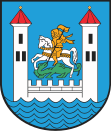Trzciel
| Trzciel | ||
|---|---|---|

|
|
|
| Basic data | ||
| State : | Poland | |
| Voivodeship : | Lebus | |
| Powiat : | Międzyrzecki | |
| Gmina : | Trzciel | |
| Area : | 3.03 km² | |
| Geographic location : | 52 ° 22 ' N , 15 ° 53' E | |
| Residents : | 2494 (December 31, 2016) | |
| Postal code : | 66-320 | |
| Telephone code : | (+48) 95 | |
| License plate : | FMI | |
| Economy and Transport | ||
| Street : | Berlin - Poznan | |
| Rail route : | Zbąszyń - Międzychód | |
| Next international airport : | Poznań-Ławica | |
Trzciel ( German Tirschtiegel ) is a town in the powiat Międzyrzecki of the Lubusz Voivodeship in Poland . The place with about 2500 inhabitants is the seat of the town-and-country municipality of the same name with about 6550 inhabitants.
Geographical location
The city is located on the Obra , about 25 kilometers southeast of the city of Międzyrzecz (Meseritz) .
history
The place was first mentioned in 1307. It was owned by the Glogau dukes and in 1319 was called Torstetel . Heinrich the Faithful ceded him to the Brandenburg Margrave; but since his house went out immediately afterwards, he did not stay with Brandenburg. The Poles took possession of it and the place name was Polonized.
Before 1394 Trzciel received city rights . The city first developed on the right bank of the Obra (Stary Trzciel) , and nowy Trzciel ( Neu-Tirschtiegel ) was added on the left bank in the 18th century . Originally part of the Polish-Lithuanian state , the city fell to Prussia with the Second Partition of Poland in 1793. The two places Alt-Tirschtiegel and Neu-Tirschtiegel were only united in 1888. They belonged to the Meseritz district , which was in the province of Posen , from 1920 in the province of Grenzmark Posen-West Prussia . Protestant religious refugees from Silesia had settled in the new town. The city was known for its hop growing and basket making.
As a result of the Treaty of Versailles , the Bentschen - Birnbaum railway line on the eastern outskirts of Tirschtiegel was struck in 1920 to form the newly formed Polish Republic. The border ran in the Tirschtiegel area about three meters to the west of the railway body. The place Tirschtiegel remained largely with Germany, but the train station, some outworks and a cemetery were in Poland. The new border also shared a house, this motif of the “house in two countries” was shown on postcards in the 1920s. Due to this demarcation, a railway connection to the west was established in 1929 by the Kleinbahn-AG Tirschtiegel - Dürrlettel .
At the beginning of World War II , a labor camp for Jews was set up in the city .
In the summer of 1944, the Hitler Youth under the direction of the Wehrmacht began building a very extensive system of trenches and trenches in the Tirschtiegel area to ward off the next big offensive expected by the Red Army . This rift system can still be seen today, especially north of Tirschtiegel in the area of the Obra chain of lakes. During the fighting in January 1945, this trench system and the Obra were mentioned as a so-called Tirschtiegel-Riegel in the Wehrmacht report, but due to snow drifts and hardly any soldiers for its occupation, it did not acquire any military significance. The advance of the Red Army, which reached Tirschtiegel with a tank brigade on the evening of January 26, 1945, passed over Tirschtiegel and Tirschtiegel-Riegel at high speed.
After the city was occupied by the Red Army in 1945 , it was placed under Polish administration a short time later . The German residents were then expelled .
Population figures before 1945
- 1800: 1,711, thereof 253 Jews
- 1837: 2.272
- 1861: 2,476
- 1890: 2,389, thereof 1,365 Protestants, 911 Catholics and 113 Jews
- 1933: 2.080
- 1939: 2,220
Attractions
- Neo-Gothic parish church of St. Adalbert (Kościół św. Wojciecha)
- Town houses
- Jewish cemetery devastated in World War II ; the former synagogue now serves as a fire station .
local community
The town itself and a number of villages belong to the town-and-country municipality (gmina miejsko-wiejska) Trzciel.
Partner communities
- Asendorf , Germany since 1993
- Falkenberg , Germany since 2000
Personalities
- The writer Anna Louisa Karsch grew up in the village (1728-1732).
- Heinrich Rau (1879–1963), socialist politician
- Herybert Menzel (died 1945 in Tirschtiegel), Nazi poet
- Lothar Müller-Nedebock (1929–1990), Lutheran clergyman, President of the Evangelical Lutheran Church in Southern Africa (Natal-Transvaal)
- Klaus Zachert (1942–2011), politician (SPD).
literature
- Heinrich Wuttke : City book of the country Posen. Codex diplomaticus: General history of the cities in the region of Poznan. Historical news from 149 individual cities . Leipzig 1864, pp. 458–459.
- Norbert Diering: Tirschtiegel in old views. European Library, Zaltbommel / Netherlands 1995, ISBN 90-288-6154-8 ( The Damals series ).
Web links
Individual evidence
- ^ A b c d e Heinrich Wuttke : City book of the country of Posen. Codex diplomaticus: General history of the cities in the region of Poznan. Historical news from 149 individual cities . Leipzig 1864, pp. 458–459.
- ^ Siegfried Bufe: Railways in East Brandenburg and Posen. Bufe-Fachbuch-Verlag, Egglham 1988, ISBN 3-922138-33-0 .
- ^ Tony Le Tissier: The Siege of Küstrin. Gateway to Berlin, 1945 . Stackpole Books, Mechanicsburg (PA) 2011, p. 18 (limited preview)
- ^ A b c Michael Rademacher: German administrative history from the unification of the empire in 1871 to the reunification in 1990. meseritz.html. (Online material for the dissertation, Osnabrück 2006).




